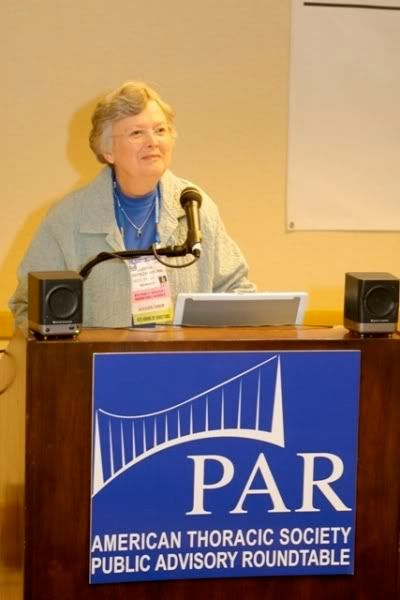 Pictured here is Judy Simpson, President of the Pulmonary Hypertension Association and Past President of PAR. She served as MC for this event.
Pictured here is Judy Simpson, President of the Pulmonary Hypertension Association and Past President of PAR. She served as MC for this event.Our first meeting at the American Thoracic Society (after we’d spent the morning eating a very fattening breakfast that certainly was not Weight Watcher’s friendly, but ohhh sooo good) was a first-time event for the society.
PAR – the Public Advisory Roundtable – has decided it wants to reach out to the general public during ATS. I wasn’t in on the planning of this event, so I’m not 100 percent certain of all the details, but essentially it was open to lung patients of all stripes to get together and network.
About 60 patients from the greater San Francisco area turned out to hear a mix of patient and doctor speakers. Afterwards there was a fofo food naushing and networking session.
There was one doctor who gave an especially phenomenal talk. I’d love to give him credit, but I can’t even begin to spell his name correctly and I can’t find it written anywhere (so if anyone knows please e-mail me). He gave a brief history of major breakthroughs in medicine over history. The last thing on his timeline, of course, was the “genetics revolution” – the idea that as we map our genome and understand how our genes work better, we’ll find that more and more of disease can be attributed to genetics. Eventually, we’ll develop gene therapies for disease (some already exist) until one day we’ll be able to tweak our genes like turning a light switch on and off.
But he believes that won’t be the end of the story.
He said that when he was a medical student, medicine was proud of its self for having “conquered” infectious disease. At the turn of the century people were much more afraid of catching something than inheriting something. But, with modern antibiotics and a working knowledge of what an infectious disease generally looks like, doctors have tools for identifying these problems and, more often than not, knocking them out.
Today, however, not only are more bugs becoming resistant to antibiotics, but according to this doctor, we’re starting to learn that there’s way more to infectious disease than we once thought.
He estimates that we only know about and have studied one percent of microbes on the face of the Earth. Furthermore, many of these microbes are so particular about their environment, that we’re only able to culture about 20 percent of those. (I didn’t have the nerve to ask him how, if we only know about one percent of microbes, we can know that 99 percent are still waiting to be discovered – but I think you get his point.)
Apparently the way some of these infectious little bugs that have been recently discovered behave is not like doctors, looking for an infectious disease, would expect them to behave and present in a patient.
This got my non-doctor mind to churning. One of the mysteries of Hermansky-Pudlak Syndrome is that the age of onset of complications like those found in types 1 and 4 can vary so widely and we don’t know why. Why is it that only 15 to 20 percent of HPS’ers develop this Crohn’s-like digestive track problem? Why is it that one person can develop pulmonary fibrosis at 19, and another with the same gene defect, might not develop pulmonary fibrosis until their 50s?
It makes me wonder, could we have inherited a genetic pre-disposition to be more susceptible to a particular infectious bug or virus, and could that be what triggers things?
If the microbe is as of yet unknown, how could we tell? I’ll have to save these questions for my next NIH trip.
After the speeches, we moved to the naushing and networking. That actually turned out to be very fruitful for me. I met some other directors of outreach from other lung patient groups and we talked about some projects we could all collaborate on that would be of benefit to everyone.
Stay tuned for further developments there!
Comments